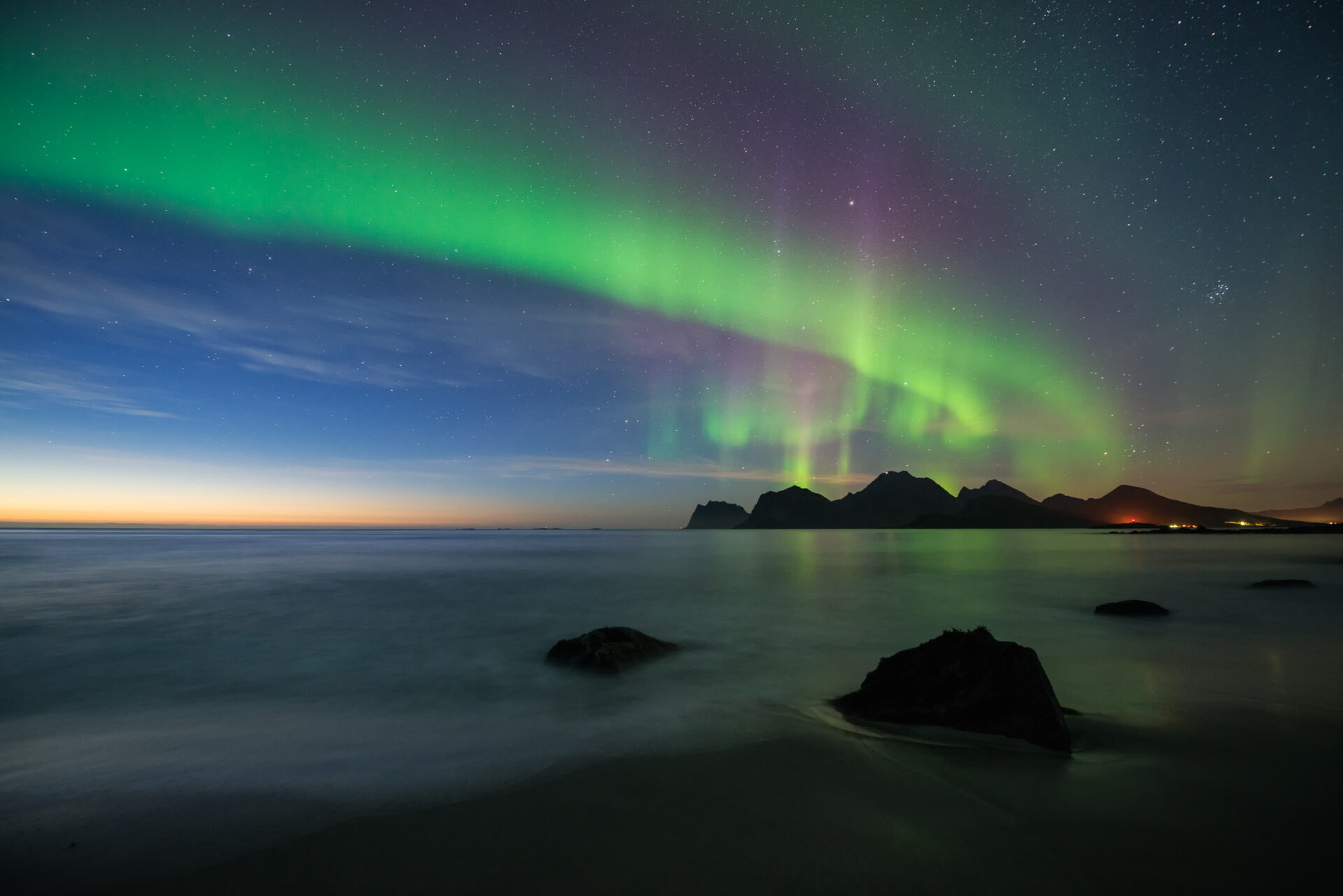 Cody Duncan
Cody Duncan
When – Where – How To See The Northern Lights
The northern lights, also known as aurora borealis, are a natural phenomenon primarily occurring in the earth’s high northern (and southern) latitudes. The northern lights occur when energy from the sun interacts with atoms in the earth’s upper atmosphere causing light to be emitted. In the most simple terms, you can almost think of northern lights as a giant neon light in the sky.
Four conditions are necessary to view the northern lights: energy from the sun, darkness, clear sky, and high northern latitude. The northern latitude and dark sky can be achieved by traveling to Lofoten – these are the two easy things! The weather and solar activity require a little more luck, chance, and patience.
Though the northern lights are often thought of as only a winter phenomenon, they do in fact occur year round. It is only that during the summer months the sky is too bright for them to be visible. However, this is actually a relatively short period of time for the Lofoten Islands, where the northern lights are first visible in late August, and slowly fade away in the spring sky in mid April.
It’s possible to see the northern lights 8 months of the year on Lofoten!
The Lofoten Islands are located in the arctic circle at 67 and 68 degrees north. This is also within what is known as the ´aurora oval´- the latitude(s) around the earth most likely to have visible northern lights. The aurora oval is a result of the earth’s magnetic sphere, which allows energy from the sun to enter the earth’s atmosphere around the magnetic poles.
The measuring of intensity of the northern lights is done using a scale called the KP index, which ranges from 0 – 9. 0 is little to no incoming energy from the sun, 3-4 is moderate energy, and above 5 is classified as a solar storm. The KP index is, however, not an exact science in regards to northern lights, but better used as rough guide of the aurora activity you might see.
The sun itself runs on an 11 year cycle of increased and decreased activity, known as the solar cycle. Luckily for us, the sun is now in a new cycle of increasing activity, meaning northern lights will become more frequent and active over the following years!
Lofoten’s location within the aurora oval means that even low amounts of incoming solar activity, about KP 1 or so, still have a good possibility of producing visible northern lights. A KP of only 2-3 can see the aurora dancing overhead. So for Lofoten, and most other high northern latitudes, a high KP number is not necessary for northern lights.
Don’t worry about the KP index. Find clear skies and you will most likely find northern lights.
There is no ‘best’ time to see the northern lights. When planning a visit to Lofoten for northern lights, you should also factor in what other activities you might want to see or do while on the islands. If you also want to be out hiking and camping, September is a better month than November. If you want to be skiing, or just have a winter look to your images, then January through March is maybe the best time for you to visit.
The long nights of November and December do not necessarily coincide with more hours of visible northern lights. During ongoing solar storms, the aurora can begin to be visible as soon as it is sufficiently dark, though this is somewhat rare. More commonly, and under average conditions, the northern lights first appear around 20:00-21:00 and fade away a little after midnight.
The northern lights do not have to be a cold experience. Did you know September has the same average temperate as June?
The dozens of sandy beaches along Lofoten’s sparsely populated northern coast are the best places to begin your aurora search as the sky begins to darken. Most beaches are easily accessed from the E10, Lofoten’s main road, and many beaches are only a few minutes apart, allowing you to quickly move from location to location if necessary. The following is why it might be necessary…
In general, the northern lights appear as an arch of light across the northern sky, with the zenith approximately due north and the points of origin northeast and northwest. So for a low aurora activity level, roughly measured as KP 1-2, you’ll want to be in a location a with an open northern horizon and sky.
As the intensity of the northern lights increases, KP 3+ on Lofoten, the aurora arch moves higher and higher in the sky, eventually reaching 90 degrees overhead and appearing to fall straight down in a phenomenon known as a corona. More importantly though, the points of origin of the aurora on the horizon also shift, slowing moving towards east and west.
To put it a little more plainly, when the aurora is very active, you don’t want to be looking north, but west or east, at which point the aurora will appear to be rising straight out of the horizon before you.
For an on the ground example from Lofoten. Uttakleiv beach is a fantastic location for low to mid level auroras, as there is good visibility of the northern horizon. However, as the beach is surrounded by mountains from west to east, as the aurora activity increases, they will move behind the mountains, and no longer be visible at Uttakleiv. At this point in time, you’ll need to move around the corner to Haukland or Vik beaches, both of which offer visibility towards the west and southwest.
On nights of high aurora activity, it can often be necessary to move between locations as the aurora moves throughout the sky. Luckily, Lofoten’s landscape is almost perfectly setup for this, so you are never too far from the perfect viewing location.
Now that you’ve found the northern lights, in the next article we’ll go into detail about getting the best photos.
Book a guided Northern Light Experience
Remove the hassle of trying to hunt for the Northern Light by letting a professional handle it. Or combine watching the “show” on the back of a horse?









